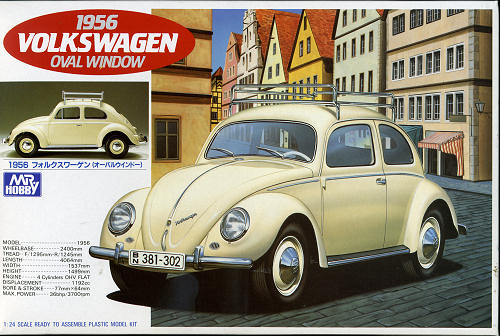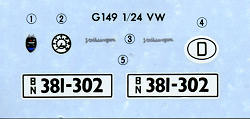| KIT #: | G-149 |
| PRICE: | $23.95 |
| DECALS: | One option |
| REVIEWER: | Scott Van Aken |
| NOTES: | 2002 release |

| HISTORY |
The Volkswagen Beetle, officially called the Volkswagen Type 1 (or informally the Volkswagen Bug), is an economy car produced by the German auto maker Volkswagen (VW) from 1938 until 2003. With over 21 million manufactured in an air-cooled, rear-engined, rear-wheel drive configuration, the Beetle is the longest-running and most-manufactured car of a single design platform anywhere in the world.
During the period of 1953-1957, the rear window of the VW Beetle evolved from a divided or "split" oval, to a singular oval. Steel used for the bodywork was at its best quality, and the Wolfsburg emblem at the tip of the front of the bonnet was a complex fabrication (subsequent models deleted the emblem). The rear 'W' decklid was hand-fabricated. The front wing had a particular 'flare out'.
| THE KIT |
 Mr.
Hobby is, of course, Gunze Sangyo, and those who have ever built Gunze kits,
know how nice they are. They are also a bit, well, eccentric. For instance, one
of the very nicely molded sprues that comes in this kit is vinyl. Yep, not only
are the tires vinyl, so are the seats and much of the interior as well as the
forward inner fenders. I have to wonder what the folks who developed this kit
were thinking as vinyl is notoriously difficult to paint. It is also difficult
to glue and several of the pieces will need to be cemented to regular injected
plastic. Perhaps there are directions to use some sort of special cement, but as
the instructions are in Japanese, figuring that out is beyond the ability of
most outside the home islands.
Mr.
Hobby is, of course, Gunze Sangyo, and those who have ever built Gunze kits,
know how nice they are. They are also a bit, well, eccentric. For instance, one
of the very nicely molded sprues that comes in this kit is vinyl. Yep, not only
are the tires vinyl, so are the seats and much of the interior as well as the
forward inner fenders. I have to wonder what the folks who developed this kit
were thinking as vinyl is notoriously difficult to paint. It is also difficult
to glue and several of the pieces will need to be cemented to regular injected
plastic. Perhaps there are directions to use some sort of special cement, but as
the instructions are in Japanese, figuring that out is beyond the ability of
most outside the home islands.
Anyway, this one is a curbside. The one piece body is very nicely molded and thought was given as to where the mold seams should go and they tend to follow natural body seams. Until you get to the front. Then, about an inch from the bottom of the body, there is a seam that goes all the way across the front. Meaning you will have to be careful removing it from all the various undulations that are there. There is a very nice representation of the underside of a flat four 1200 cc air cooled engine, part of the lower swing arm suspension and part of its exhaust molded onto a piece that glues onto the main floor pan. This floor pan includes all the interior attachments on the reverse side. This includes the pedals, gear shift, parking brake and the seats. There is the usual floor stiffener that carries the shift linkage back to the transmission.
To this central part, you attach the separate front
suspension, which itself is superbly molded and looks just like the torsion
bar version you get in a VW. The underside of the forward trunk and the
rubber sidewalls attach to that. All of the windows are separate and
designed to be inserted from inside the body so it is important that you
paint the body prior to attaching all the bits to it. One of the vinyl parts
is a front windshield gasket. The dash and steering wheel assembly fit into
the body as do the vinyl interior side panel bits. Onto the side panels fit
the door handles and window winders. The last bits are the headlight
assemblies, bumpers wiper and tail lights. There is also a nicely done roof
rack, which must have been a po pular
item in Europe as I do not recall seeing many in the US. The chrome parts
are particularly well done and so molded that there really is not much in
the way of a seam to remove, only where the sprues attach will there need to
be any attention given as to restoration of the chrome.
pular
item in Europe as I do not recall seeing many in the US. The chrome parts
are particularly well done and so molded that there really is not much in
the way of a seam to remove, only where the sprues attach will there need to
be any attention given as to restoration of the chrome.
As mentioned, the instructions are in Japanes with the paint colors called out in Gunze colors. The construction steps are well drawn so there will be no issue as to what attaches where. The small decal sheet provides logos, the instrument and plates.
| CONCLUSIONS |
There are segments of car fiends who like VWs and those who like economy cars. Then there are those of us who owned Beetles at some time during our life. All of these folks are well catered to with this one. Best yet, it will not take up much shelf space, and chicks like it.
| REFERENCES |
http://en.wikipedia.org/wiki/Volkswagen_Beetle
August 2012
Thanks to me for this one
If you would like your product reviewed fairly and fairly quickly, please contact the editor or see other details in the Note to Contributors.